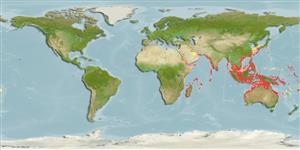Elasmobranchii (Haie und Rochen) (sharks and rays) >
Myliobatiformes (Stingrays) >
Aetobatidae (Pacific eagle rays)
Etymology: Aetobatus: Greek, aetos = eagle + Greek, batis, batidos = a ray (Raja sp.) (Ref. 45335).
More on authors: Bloch & Schneider.
Environment: milieu / climate zone / depth range / distribution range
Ökologie
seewasser; brackwasser benthopelagisch; amphidrom (Ref. 51243). Tropical
Indo-West: Persian Gulf to Borneo (patchy distribution).
Size / Gewicht / Alter
Maturity: Lm ? range ? - ? cm
Max length : 72.0 cm WD Männchen/unbestimmt; (Ref. 4440); max. veröff. Gewicht: 13.9 kg (Ref. 40637)
This species is characterized by the following: dorsal without spots or rings; long rostral lobe (longest in adult males) and narrowly pointed; disc very broad and short, its length 55-70% WD; pectoral fins weakly falcate and joining head at eye level, separate from rostral lobe; posterior margins moderately concave, rear tips free and broadly rounded; spiracles large, dorsolateral and visible in dorsal view; mouth ventral, its width narrower than preoral length; nasal curtain large, deeply notched centrally and with a curtain-like fringe; teeth plate-like in a single row, the upper teeth transverse, lower chevron-shaped; disc entirely smooth, no denticles or thorns; tail elongate, whip-like, ca. 1.2-2.8 times WD when undamaged; dorsal-fin small and raked back, apex broadly rounded, free rear tip short with origin behind pelvic-fin insertions; caudal stings 1 or 2, longest greater than preoral length. Colour uniform brownish or greenish brown, mostly white ventrally, pectoral tips and posterior margins of disc mostly pale brownish (Ref. 114953).
Inhabits inshore waters (Ref. 9862). Probably feeds on hard-shelled and bottom-dwelling invertebrates (Ref. 114953). Often found in brackish waters (Ref. 4832). Ovoviviparous (Ref. 50449). Caught occasionally by bottom trawl and inshore demersal gillnet fisheries off Jakarta. Utilized for its meat, but of limited value due to its rarity and small size (Ref.58048).
Life cycle and mating behavior
Geschlechtsreife | Fortpflanzung | Ablaichen | Eier | Fecundity | Larven
Exhibit ovoviparity (aplacental viviparity), with embryos feeding initially on yolk, then receiving additional nourishment from the mother by indirect absorption of uterine fluid enriched with mucus, fat or protein through specialised structures (Ref. 50449).
McEachran, J.D. and B. Séret, 1990. Myliobatididae. p. 67-70. In J.C. Quero, J.C. Hureau, C. Karrer, A. Post and L. Saldanha (eds.) Check-list of the fishes of the eastern tropical Atlantic (CLOFETA). JNICT, Lisbon; SEI, Paris; and UNESCO, Paris. Vol. 1. (Ref. 4440)
IUCN Rote Liste Status (Ref. 130435: Version 2024-2)
Bedrohung für Menschen
Harmless
Nutzung durch Menschen
Fischereien: weniger kommerziell
Tools
Zusatzinformationen
Download XML
Internet Quellen
Estimates based on models
Preferred temperature (Ref.
123201): 24.2 - 29.2, mean 28.2 °C (based on 1688 cells).
Phylogenetic diversity index (Ref.
82804): PD
50 = 0.6250 [Uniqueness, from 0.5 = low to 2.0 = high].
Bayesian length-weight: a=0.01000 (0.00244 - 0.04107), b=3.04 (2.81 - 3.27), in cm total length, based on all LWR estimates for this body shape (Ref.
93245).
Trophic level (Ref.
69278): 3.6 ±0.5 se; based on size and trophs of closest relatives
Widerstandsfähigkeit (Ref.
120179): niedrig, Verdopplung der Population dauert 4,5 - 14 Jahre. (Fec assumed to be <100).
Fishing Vulnerability (Ref.
59153): Very high vulnerability (85 of 100).
